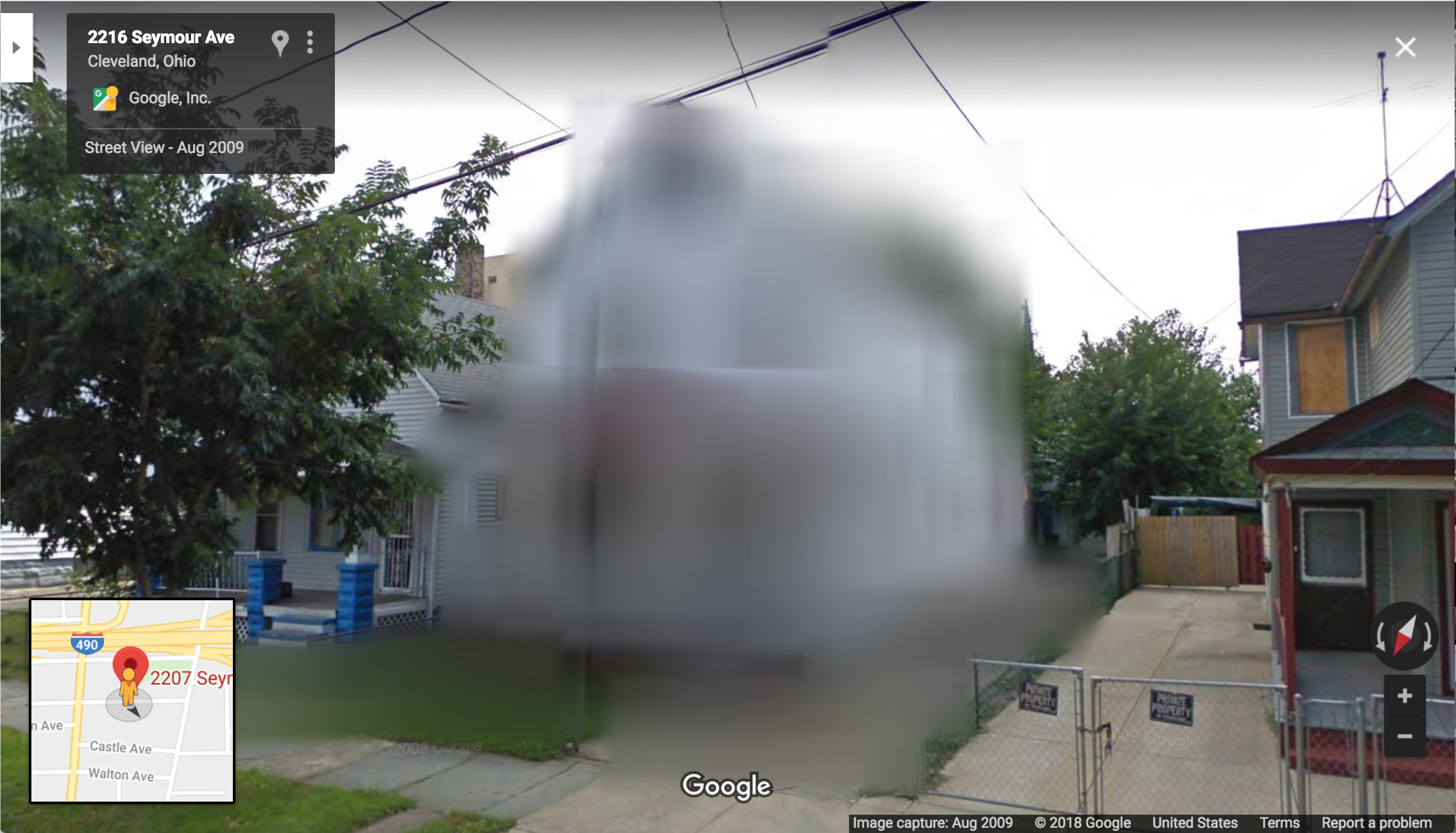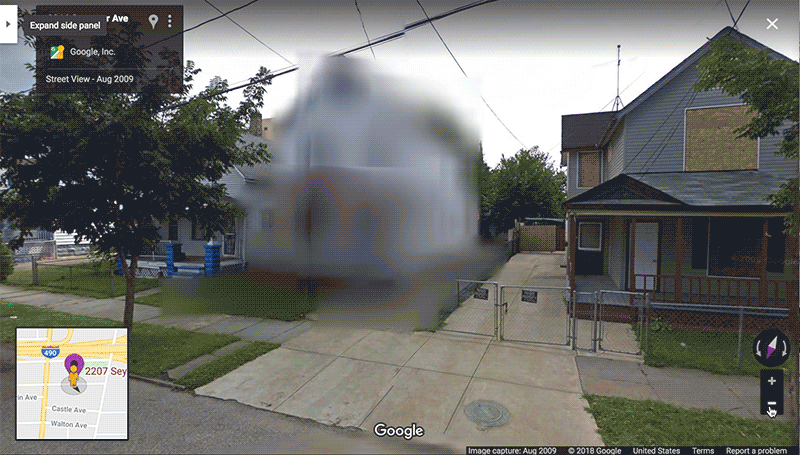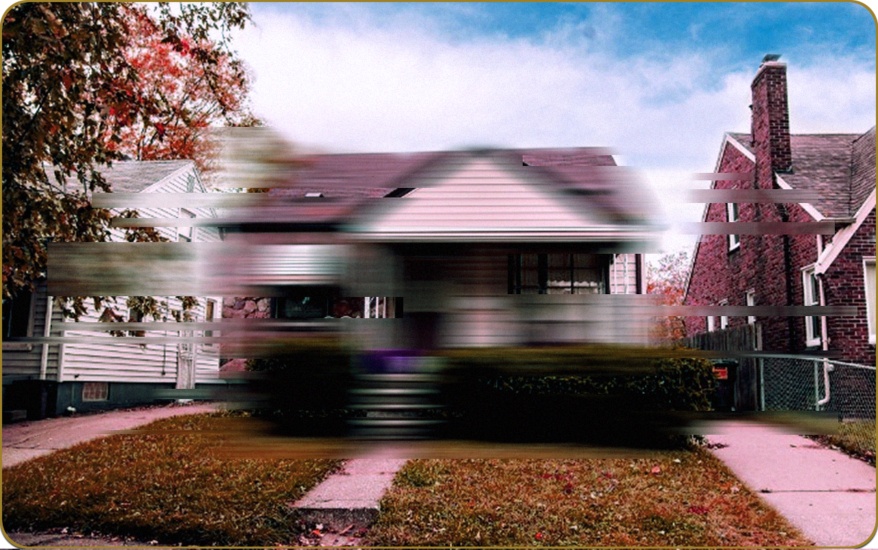GUIDED TOURS is a look at a historical or cultural site undertaken on Street View, led by a knowledgeable escort. Tours can last the length of one long exposure or block; others can take in multiple sites and last for decades. If you’d like to nominate a place, please walk us through it.
There is a house on Street View that Google has deemed impossible. 2207 Seymour Ave, in Cleveland, Ohio, was the four-story unit where Ariel Castro kept and tortured three women from 2002 to 2013, until Amanda Berry managed to escape and alert neighbors to their captivity. The acts that Castro committed were so heinous that a controlled demolition of the building was required in his plea bargain. A former neighbor told the Guardian that razing the house was important to show “that monster … is behind bars and that he’s never going to get out.”
On Street View, the block remains frozen in the year 2009. The image was taken while the crime was still taking place, and although an early screengrab circulating on message boards shows a house with boarded windows, Street View now blurs the house beyond recognition as a thing of brick and mortar.

When a reporter from Mashable inquired about Google’s censorship, a representative referred them to the company’s privacy and security policy, which allows viewers to report “an objectionable image” containing inappropriate content including violence, sexual imagery, or promotion of child endangerment. By blurring out the home — literally making it less objectionable — Google has implied that what happened inside the house is beyond comprehension; the company has unmoored the once-physical 2207 Seymour Avenue from the concept of the house. This clumsy attempt to distract us from tragedy neither protects virtual visitors nor honors its victims — rather, in altering its own records, Google turns the site into a horror trope.
The house’s demolition, and subsequent “deletion,” calls to mind what horror philosopher Eugene Thacker, in Tentacles Longer Than Night, refers to as the “negative theology” of protagonists in weird fiction stories, applying this religious philosophy (and literary device) to a transgressive subgenre of speculative fiction. Confronted by beings or places that are so awful as to be indescribable, and having reached their complete threshold for horror, weird fiction protagonists fall back upon “a strategy of minimalism, in which language is stripped of all its attributes, leaving only skeletal phrases such as ‘the nameless thing,’ ‘the shapeless thing,’ or ‘the unnamable.’”
Thacker cites an example from H.P. Lovecraft’s At The Mountains of Madness: “We had expected, upon looking back, to see a terrible and incredibly moving entity … What we did see — for the mists were indeed all too malignly thinned — was something altogether different, and immeasurably more hideous and detestable. It was the utter, objective embodiment of the fantastic novelist’s ‘thing that should not be.’” Google, in its own way, seems to have innovated a visual attempt at a negative theology.

On Street View one can attempt to glimpse 2207 Seymour Avenue, circa 2009, from behind, but in these shots the house is hidden by trees or other buildings. Try the view from above, and you’ll find yourself suddenly in the present day, looking down at the razed ground the building once occupied. Zooming out, the blur vanishes; zooming in, it reappears. This has the visual effect of a small bomb detonating. As though what happened was so awful it destroyed the space around it.
Street View offers no timeline adjustment options until you travel to the far west end of the block, where you can adjust the view from 2007 to 2017. But if you take one more step back — just enough to maybe glimpse the Castro unit — you’re flung back to 2009, and the blur. The same goes for the easternmost end of the block, where walking into the cross streets of Scranton and Seymour allows you access to 2007, 2009, 2016, and 2017. No matter where you try to catch a glimpse, there is no way to see the Castro house at any point in its history. And, paradoxically, as long as you are standing before 2207 Seymour, you are stuck in 2009: The crimes are taking place right in front of you, but you cannot see them.
The overwhelming sense of hopelessness and the inability to intervene is echoed in literary works by authors such as Flann O’Brien (The Third Policeman) and J.B. Priestley (An Inspector Calls; I Have Been Here Before), who mined philosophies of time for tragedy and terror. Perhaps the most famous philosopher was J.W. Dunne, whose theory of “serialism” posited that our perception of time as linear is an illusion: To put it crudely, the past, present, and future are all happening at once. A fourth-dimensional version of ourselves has experienced it all already, and can feed the other versions information about the future.
Dunne likely did not anticipate that his work would be mined for horror, but it’s easy to understand the horrific possibilities inherent in this idea: That one has, will, and is always experiencing their life’s great tragedies, with the possibility that maybe — just maybe — another version of ourselves could send a message back to save us.
Clicking up and down the unpopulated block, you have that exact sense of being unhelpful and alone in your terrible knowledge of what is happening right in front of you. It’s 2018; it happened. It’s 2009; it’s happening. The survivors of Castro’s violence remain in that blur on Seymour Ave, where you cannot see them, they cannot see you, and neither of you can offer each other comfort. No matter how hard you try, you cannot send a message to any neighbors or passersby that could stop the atrocity.
There is a distinction to be made between the physical demolition of the building, in present day, and the awkward erasure of its eternal digitized version. While unorthodox for the site of a crime, the razing of the home does not ignore what happened in the past. Rather, it seems a practical way to acknowledge that tragedy occurred, as well as an appropriate way for the rest of the neighborhood to “move on” — for lack of a better term. After all, part of the horror is the fact that neighbors within a dozen or two dozen feet of the crimes themselves had no idea they were happening. Google’s virtual attempt at redress reproduces the horror by creating its inverse: You know exactly what’s happening but you’re powerless to do anything about it.
I am not sure how I expected to feel when I first looked up the address on Google Maps. My search stemmed from a curiosity about how the tech giant memorialized — or ignored — sites of publicized crimes. I have to imagine that, like myself, most other virtual visitors to the home were checking off a list of similar sites. One expects to see a building, even the outline of one, and in a remote way to reckon with its history; but the effect of these abstracted pixels is nothing but a shock.
What are we to do with the horror on Seymour Avenue? It seems a disservice to blur out a house, call it unknowable, and click to the end of the street. There are, after all, houses that are crystal clear, with crimes taking place inside that we know nothing about yet. Thousands of people are trafficked in the United States alone. Several thousand more would be considered modern slaves. And there are plenty of houses with crimes we know about that haven’t been censored: the Los Angeles home of the Grim Sleeper; Israel Keyes’s home in Anchorage with his truck out front; the Antioch street of the Garrido couple.
If Google intends for its Maps and Street View to be a catalogue of time and space, there is no reason for Castro’s house to violate the laws of nature. That gives him far too much credit. The literary examples I cite are not intended to make an intellectual exercise out of a real tragedy, but rather as context for why Google’s choice makes reality fantastical, when it must be reconciled with. I have always thought that understanding evil is necessary for countering it. And to see a full, true outline of horror — not just a smear of color — is the first and simplest step toward comprehension.
